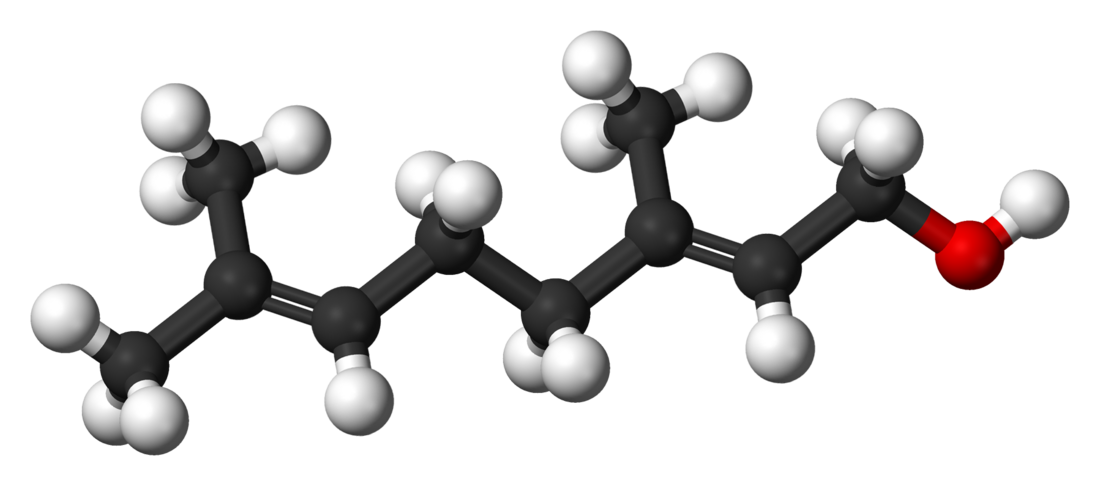Geraniol
Monoterpenoid and alcohol that is the primary component of citronella oil From Wikipedia, the free encyclopedia
Geraniol is a monoterpenoid and an alcohol. It is the primary component of citronella oil and is a primary component of rose oil and palmarosa oil. It is a colorless oil, although commercial samples can appear yellow. It has low solubility in water, but it is soluble in common organic solvents.
 | |
| Names | |
|---|---|
| Preferred IUPAC name
(2E)-3,7-Dimethylocta-2,6-dien-1-ol | |
| Identifiers | |
3D model (JSmol) |
|
| ChEBI | |
| ChEMBL | |
| ChemSpider | |
| DrugBank | |
| ECHA InfoCard | 100.003.071 |
| EC Number |
|
| KEGG | |
PubChem CID |
|
| UNII | |
CompTox Dashboard (EPA) |
|
| |
| |
| Properties | |
| C10H18O | |
| Molar mass | 154.253 g·mol−1 |
| Density | 0.889 g/cm3 |
| Melting point | −15 °C (5 °F; 258 K)[2] |
| Boiling point | 230 °C (446 °F; 503 K)[2] |
| 686 mg/L (20 °C)[2] | |
| log P | 3.28[3] |
| Hazards | |
| NFPA 704 (fire diamond) | |
Except where otherwise noted, data are given for materials in their standard state (at 25 °C [77 °F], 100 kPa).
| |
Uses and occurrence
In addition to being found in rose oil, palmarosa oil, and citronella oil, it also occurs in small quantities in geranium, lemon, and many other essential oils. With a rose-like scent,[5] it is commonly used in perfumes and in scents such as peach, raspberry, grapefruit, red apple, plum, lime, orange, lemon, watermelon, pineapple, and blueberry.
Geraniol is produced by the scent glands of honeybees to mark nectar-bearing flowers and locate the entrances to their hives.[6] It is also commonly used as an insect repellent, especially for mosquitoes.[7]
The scent of geraniol is reminiscent of, but chemically unrelated to, 2-ethoxy-3,5-hexadiene, also known as geranium taint, a wine fault resulting from fermentation of sorbic acid by lactic acid bacteria.[8]
Geranyl pyrophosphate is important in biosynthesis of other terpenes such as myrcene and ocimene.[9] It is also used in the biosynthesis pathway of many cannabinoids in the form of CBGA.[10]
Reactions
In acidic solutions, geraniol is converted to the cyclic terpene α-terpineol. The alcohol group undergoes expected reactions. It can be converted to the tosylate, which is a precursor to the chloride. Geranyl chloride also arises by the Appel reaction by treating geraniol with triphenylphosphine and carbon tetrachloride.[11][12] It can be oxidized to the aldehyde geranial.[13] Hydrogenation of the two C=C bonds over a nickel catalyst gives tetrahydrogeraniol.[14][15]
Health and safety
Geraniol is classified as D2B (Toxic materials causing other effects) using the Workplace Hazardous Materials Information System (WHMIS).[16]
History
Geraniol was first isolated in pure form in 1871 by the German chemist Oscar Jacobsen (1840–1889).[17][18] Using distillation, Jacobsen obtained geraniol from an essential oil produced in India which was obtained from the so-called geranium grass.[19] This essence, after which the compound was named, was a 50% cheaper substitute for the essence of the proper geranium flower with a similar, although less delicate, odor.[20]
The chemical structure of geraniol was determined in 1919 by the French chemist Albert Verley (1867–1959).[21]
See also
References
External links
Wikiwand - on
Seamless Wikipedia browsing. On steroids.


